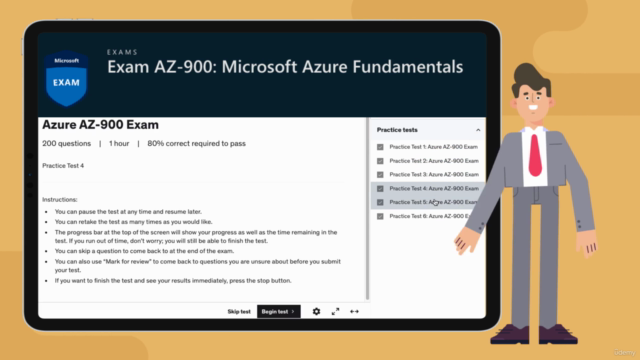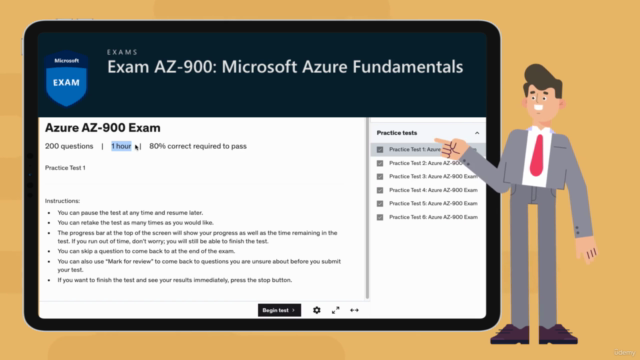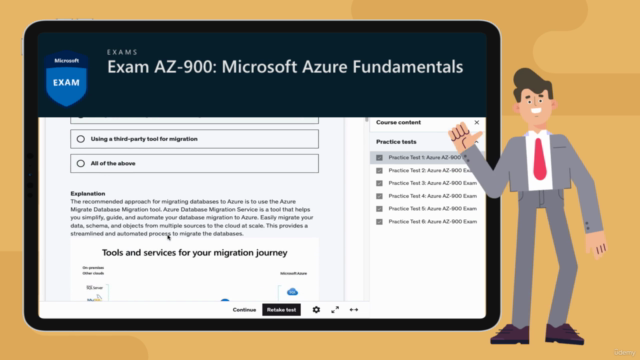AZ-900: Microsoft Azure Fundamentals, 1000+ Q&A, 2023
Master the Essentials of Microsoft Azure with Comprehensive Practice Questions

What you will learn
Describe Azure cloud concepts
Describe Azure architecture and services
Describe Azure management and governance
Prepare and be confident for Azure AZ-900
Why take this course?
The AZ-900: Microsoft Azure Fundamentals Question Bank is designed for individuals who want to take a Microsoft certification exam.
The tests contain 1000+ Azure questions with detailed explanation mainly focusing on the below areas.
Describe cloud concepts (25–30%)
Describe Azure architecture and services (35–40%)
Describe Azure management and governance (30–35%)
Describe cloud concepts (25–30%)
Describe cloud computing
Define cloud computing
Describe the shared responsibility model
Define cloud models, including public, private, and hybrid
Identify appropriate use cases for each cloud model
Describe the consumption-based model
Compare cloud pricing models
Describe the benefits of using cloud services
Describe the benefits of high availability and scalability in the cloud
Describe the benefits of reliability and predictability in the cloud
Describe the benefits of security and governance in the cloud
Describe the benefits of manageability in the cloud
Describe cloud service types
Describe infrastructure as a service (IaaS)
Describe platform as a service (PaaS)
Describe software as a service (SaaS)
Identify appropriate use cases for each cloud service (IaaS, PaaS, SaaS)
Describe Azure architecture and services (35–40%)
Describe the core architectural components of Azure
Describe Azure regions, region pairs, and sovereign regions
Describe availability zones
Describe Azure datacenters
Describe Azure resources and resource groups
Describe subscriptions
Describe management groups
Describe the hierarchy of resource groups, subscriptions, and management groups
Describe Azure compute and networking services
Compare compute types, including container instances, virtual machines (VMs), and functions
Describe VM options, including Azure Virtual Machines, Azure Virtual Machine Scale Sets, availability sets, and Azure Virtual Desktop
Describe resources required for virtual machines
Describe application hosting options, including the Web Apps feature of Azure App Service, containers, nd virtual machines
Describe virtual networking, including the purpose of Azure Virtual Networks, Azure virtual subnets, peering, Azure DNS, Azure VPN Gateway, and Azure ExpressRoute
Define public and private endpoints
Describe Azure storage services
Compare Azure storage services
Describe storage tiers
Describe redundancy options
Describe storage account options and storage types
Identify options for moving files, including AzCopy, Azure Storage Explorer, and Azure File Sync
Describe migration options, including Azure Migrate and Azure Data Box
Describe Azure identity, access, and security
Describe directory services in Azure, including Microsoft Azure Active Directory (Azure AD), part of Microsoft Entra and Azure Active Directory Domain Services (Azure AD DS)
Describe authentication methods in Azure, including single sign-on (SSO), multifactor authentication, and passwordless
Describe external identities and guest access in Azure
Describe Conditional Access in Microsoft Azure Active Directory (Azure AD), part of Microsoft Entra
Describe Azure role-based access control (RBAC)
Describe the concept of Zero Trust
Describe the purpose of the defense in depth model
Describe the purpose of Microsoft Defender for Cloud
Describe Azure management and governance (30–35%)
Describe cost management in Azure
Describe factors that can affect costs in Azure
Compare the Pricing calculator and the Total Cost of Ownership (TCO) calculator
Describe the Azure Cost Management and Billing tool
Describe the purpose of tags
Describe features and tools in Azure for governance and compliance
Describe the purpose of Azure Blueprints
Describe the purpose of Azure Policy
Describe the purpose of resource locks
Describe the purpose of the Service Trust Portal
Describe features and tools for managing and deploying Azure resources
Describe the Azure portal
Describe Azure Cloud Shell, including Azure CLI and Azure PowerShell
Describe the purpose of Azure Arc
Describe Azure Resource Manager and Azure Resource Manager templates (ARM templates)
Describe monitoring tools in Azure
Describe the purpose of Azure Advisor
Describe Azure Service Health
Describe Azure Monitor, including Log Analytics, Azure Monitor alerts, and Application Insights
Candidates for this exam are technology professionals who want to demonstrate foundational knowledge of cloud concepts and Microsoft Azure. These professionals can describe Azure architectural components and Azure services, such as compute, networking, and storage. They can also describe features and tools to secure, govern, and administer Azure. Candidates for this exam have skills and experience working with an area of information technology, such as infrastructure management, database management, or software development.
Screenshots



